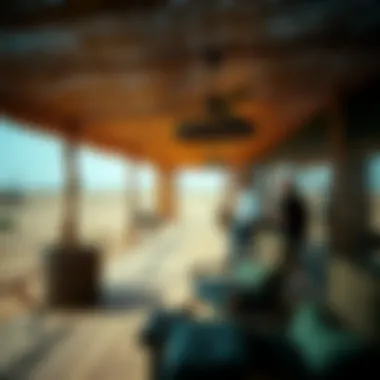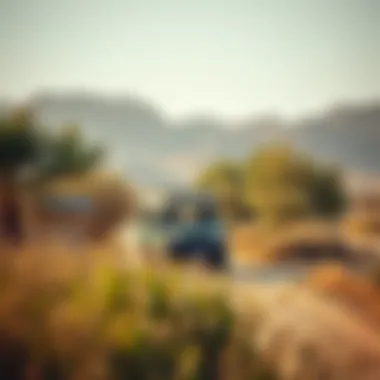Safari Adventure in Al Ain: Culture and Wildlife


Intro
The desert landscape of Al Ain, often dubbed as the "Garden City" because of its lush oases and unique wildlife, offers a safari experience unlike any other. Nestled away from the clamor of big cities, Al Ain presents an area rich in cultural history and breathtaking natural beauty. The blend of these elements draws tourists, nature enthusiasts, and adventure seekers alike, making for a thrilling exploration.
A Fusion of Culture and Wilderness
Embarking on a safari in Al Ain isn't just about the chance to spot an array of flora and fauna; it's a deep dive into the very fabric of Bedouin culture that has thrived in these arid climes for centuries. The experience is thoughtfully curated to connect visitors with the historical significance of the land while engaging with its wildlife.
In Al Ain, you'll encounter species native to the Arabian Peninsula, including Arabian oryx, gazelles, and numerous bird species. The dynamic ecosystem here is not merely a backdrop; it plays a vital role in local culture and tradition, portraying how the environment shapes livelihoods and stories.
Market Insights
Current Trends in Safari Tourism
The safari experience in Al Ain has witnessed significant growth over the past few years. As more travelers seek experiences that provide both adventure and education, the demand for wildlife tours, particularly in unique settings like Al Ain, has increased. Travelers are eager to explore places where they can engage with nature while also learning about its conservation and cultural significance.
- The rise in eco-tourism has sparked interest in sites like Al Ain, which promote responsible interactions with wildlife.
- An increased emphasis on sustainability has encouraged local operators to enhance tour offerings, focusing on preserving both wildlife and the cultural treasures of the region.
Investment Opportunities in Eco-Tourism
There are substantial opportunities within Al Ain's eco-tourism sector. As interest swells, savvy investors can leverage this momentum to tap into the developing market.
- Sustainable Safari Ventures: Eco-lodges and guided tour services are popping up, catering to the growing demand for authentic experiences.
- Long-term Rentals: For those looking to invest in property, the growth of safari tourism is making long-term rentals appealing, especially for tourists wishing to immerse themselves in the experience for extended periods.
As the area continues to attract attention, understanding these market dynamics will be crucial for stakeholders looking to invest or expand their offerings in Al Ain's thriving safari scene.
Intro to Safari Al Ain
The safari experience in Al Ain isn't just a stroll in the sand; it’s a deep dive into a vibrant landscape filled with history, culture, and the wild beauty of nature. Understanding the significance of this topic lays the groundwork for appreciating what awaits travelers in this splendid desert environment. It’s about engaging with a remarkable fusion of the rich heritage of the Bedouins and the precious wildlife that thrives amidst the towering dunes and rocky outcrops of Al Ain.
Origin and Concept
The beginnings of the safari in Al Ain can be traced back to the region's ties to nomadic Bedouin culture, where exploration of the land was both a necessity and an adventure. The concept of a safari evolved over time, transforming from a traditional mode of discovery into a sought-after experience for tourists. In the past, Bedouins were adept at extracting the beauty and utility of their harsh environment, and this spirit lives on in today's safaris.
This evolution speaks volumes about the adaptability of the local community. It reflects how cultural heritage has been harmonized with modern tourism demands. Visitors now find themselves roaming the same expanses where ancient tribes once lead their camels, reflecting on the profound shifts that time has brought.
Cultural Context
Delving into the cultural context of the safari in Al Ain offers insights into the very essence of this adventure. The landscape is steeped in stories of resilience and tradition that date back centuries. The Bedouins skilled in surviving the harsh desert conditions have imbued the area with a legacy of wisdom regarding local flora and fauna.
Interactions with locals during safaris provide a unique opportunity to experience this rich cultural tapestry firsthand. From sharing tales of their ancestors to partaking in authentic rituals, tourists can witness the harmony between mankind and nature that characterizes the region.
"A journey through Al Ain’s vast desert is not just a trip; it’s an open book of the past, waiting to be read by all who come."
The vibrant spice markets, traditional music, and artistic expressions rooted in the desert way of life can add depth to the safari experience. Understanding these cultural nuances enhances the encounter, directs meaningful conversations, and fosters respectful relationships between visitors and residents.
In summary, the safari experience in Al Ain is much more than an engagement with wildlife; it is a window into the heart of an ancient culture that respects its surroundings deeply. As travelers lace up their boots and prepare for the adventure ahead, having a grasp of where they are stepping is pivotal, paving the way for a richer and more involved journey.
The Landscape of Al Ain
The Landscape of Al Ain plays a pivotal role in shaping the safari experience, intertwining the essence of the desert with the diverse wildlife and rich cultural history. Understanding this unique landscape is essential for everyone seeking an immersive experience in this region. Al Ain is not just a series of dunes and rocks; it is alive with the vibrant interplay of ecology and topography. The breathtaking vistas of the Hajar Mountains and soft undulating sands make it a photographer’s dream, while also providing habitats for various species. Visitors are drawn not only to the thrilling encounters with wildlife but also to the serene beauty that surrounds them.
Geographical Features


Al Ain's geographical layout is a mosaic of enchanting features that contribute significantly to the safari experience. This area is wrapped around the foothills of the Hajar Mountains, creating a dramatic backdrop against wide, fluctuating terrain that merges sandy deserts and rocky inclines. Here’s a closer look at some notable features:
- Mountains: The Hajar Mountains act as the spine of this landscape, providing not only a striking visual element but also influencing the weather and climate of the surrounding areas. The cooler temperatures and lush oases that form in the valleys below are in stark contrast to the arid Arabian desert, offering unique ecosystems.
- Oases: Al Ain is famously known as the ‘Garden City’ thanks to its lush oases, such as Al Ain Oasis and the lush landscape of the Al Ain National Museum. These areas provide critical sustenance for wildlife and are often the best spots for spotting various birds and small mammals.
- Sand Dunes: The gently rolling sand dunes are iconic to Al Ain. These dunes, shaped by wind patterns, create an ever-changing landscape. Driving or riding camel back across these dunes offers an exhilarating yet peaceful perspective of the desert.
In summary, these geographical features not only shape the visual allure of the region but also foster biodiversity and cultural heritage, making them integral to the safari experience.
Flora and Fauna
The interaction between the landscape and the diverse flora and fauna of Al Ain reveals a vibrant ecosystem that visitors often find fascinating. The harsh desert environment has nurtured unique forms of life, with a significant number of species adapted brilliantly to thrive in such challenging conditions.
- Flora: The desert is not devoid of life when it comes to plant species. Unique vegetation like the ghaf tree, date palms, and various shrubs can be spotted, playing crucial roles in maintaining the ecosystem. The ghaf tree, in particular, is a symbol of resilience and has profound cultural significance, providing shade and habitat.
- Fauna: The wildlife of Al Ain is equally impressive. Visitors can expect to encounter creatures such as:
- Arabian Oryx: A magnificent symbol of the desert, this antelope was once nearly extinct and has made a commendable recovery thanks to conservation efforts.
- Sand Gazelles: Agile and graceful, these gazelles are well-adapted to their surroundings, able to traverse the terrain with ease.
- Bird Species: The landscape also serves as a haven for various bird species, including falcons and other migratory birds, making it a prime spot for birdwatching enthusiasts.
Understanding the flora and fauna not only enriches the safari experience but also underscores the importance of conservation and awareness regarding preserving these natural treasures. As you traverse through this beautiful landscape, appreciating the delicate balance of life that thrives in one of the world's harshest environments will deepen your understanding and enjoyment of the experience.
"The desert does not merely contain life; it embraces a complexity that speaks volumes about survival and adaptation in its most raw form."
This connection between the landscape, flora, and fauna paints a clearer picture for those interested in truly understanding what Al Ain has to offer. It is essential for investors, homeowners, real estate agents, and conservationists to recognize the value of preserving these elements as they develop and explore the area further.
Diversity of Wildlife
When it comes to understanding the safari experience in Al Ain, the emphasis on wildlife diversity cannot be overstated. This aspect is central not just to the environment but also to the cultural fabric of the region. The variety of species inhabiting the area offers a unique blend of visual wonders and educational opportunities, attracting both tourists and nature enthusiasts alike. Importantly, the presence of different wildlife forms a delicate balance within the ecosystem, highlighting the intricate relationships that exist in nature.
Species Overview
The safari in Al Ain is home to a fascinating array of species, both native and introduced. From the majestic Arabian Oryx to shy gazelles, the area is teeming with life. Here’s a closer look at some notable species:
- Arabian Oryx: Once considered extinct in the wild, these striking animals boast a magnificent pair of long horns and are a symbol of successful conservation efforts.
- Sand Gazelle: Adapted to desert life, these nimble creatures are known for their speed and endurance, navigating through the sandy terrain effortlessly.
- Desert Fox: This cunning little creature can be spotted at dusk. With its large ears and soft fur, it's perfectly built for life in the harsh desert.
- Various Birds: Over 300 avian species migrate through Al Ain. From the colorful Arabian Partridge to the majestic Shikra, every bird sighting enriches the safari experience.
These species, among others, contribute to a complex food web that showcases the biodiversity vital to the ecosystem's health. Additionally, many of these animals serve as indicators of environmental changes, making them essential for monitoring ecological balance.
Endangered Species and Conservation
Conservation is a pressing concern within the safari context, primarily because several species in Al Ain face threats. Ensuring their survival is not just crucial for biodiversity; it is also a reflection of our responsibility towards future generations. Some species in danger include:
- Arabian Leopard: This elusive feline, critically endangered, requires urgent conservation efforts. Habitat loss plays a significant role in its declining numbers.
- Houbara Bustard: Once abundant, this bird has seen significant population reductions due to hunting and habitat degradation, emphasizing the need for protective legislation.
Several organizations, including the Environment Agency - Abu Dhabi, are actively working on conservation programs aimed at educating the public and preserving these species.
“Protecting wildlife not only nurtures the environment but is also a commitment to maintaining harmony between humans and nature.”
Community engagement initiatives in Al Ain have also emerged, encouraging locals and visitors to adopt sustainable practices. Conservation awareness campaigns help foster a sense of stewardship of the land and its inhabitants.
In essence, the diverse wildlife of Al Ain plays a crucial role in shaping the safari experience. To truly appreciate this, visitors must delve deeper into the ecosystems and their inhabitants, recognizing the delicate balance that sustains life in this striking desert habitat.
Types of Safari Experiences
The safari experience in Al Ain is not just a journey through the desert; it’s a multifaceted adventure that offers a medley of experiences tailored to various interests and preferences. Each type of safari presents unique opportunities to engage with the natural environment and the rich cultural heritage of the region. From the tranquil pace of camel safaris to the thrill of 4WD adventures, and the intimate connection found in walking tours, every option provides visitors with a distinctive way to appreciate the vast desert landscape.
Camel Safaris
Camel safaris are perhaps the most traditional form of exploring the Al Ain desert. These majestic creatures, often referred to as the ship of the desert, carry a rich symbolism in Arabian culture, epitomizing resilience and strength. Riding a camel, one can’t help but feel an intrinsic connection to the history of the region. These safaris take you across sandy dunes where the rhythm of the camel's gait provides a soothing backdrop to the breathtaking surroundings.
"Camel safaris invite a slow exploration, allowing for time to absorb the beauty of the desert and observe wildlife without disruption."


Visitors can choose from various itineraries, including sunset rides that paint the sky with exquisite hues, making these moments not just visually striking but emotionally resonant. The major advantage of camel safaris is their ability to engage travelers in the culture and traditions woven around camel herding and Bedouin lifestyles, providing a rich narrative alongside the ride.
4WD Adventures
For those seeking a more adrenaline-pumping experience, 4WD adventures offer a thrilling ride across the rugged terrain of Al Ain. In contrast to the leisurely pace of camel safaris, these excursions are about speed, agility, and skillful navigation through challenging landscapes. Professional guides ensure safety while enhancing the excitement of traversing steep dunes and unexpected formations.
One noteworthy aspect of 4WD safaris is the opportunity for wildlife spotting. Various ecosystems exist within the region, and a 4WD can cover larger distances, allowing for encounters with diverse fauna. Travelers can expect not only to race through stunning landscapes but also to experience breathtaking views atop the higher dunes where the desert stretches infinitely. In short, for thrill-seekers, 4WD adventures provide a blend of excitement and exploration that is hard to match.
Walking Tours
For a more intimate experience, walking tours immerse you in the details of the desert’s flora and fauna, emphasizing the connection between nature and culture. These tours encourage participants to engage all the senses—feeling the crunch of sand beneath their feet, breathing in the crisp desert air, and observing the minutiae of life, from desert plants to delicate animal tracks.
Guided by knowledgeable local experts, walking safaris often focus on the ecological significance of the desert, emphasizing sustainability and conservation. Visitors learn about the traditional uses of plants, the symbiotic relationships within the ecosystem, and how local communities have adapted to the harsh environment over generations.
Perhaps one of the most enriching aspects of walking tours is the personal connection formed with the land. This option is particularly appealing for those looking to escape the more commercial aspects of tourism and delve deeper into the desert’s untouched beauty, fostering a genuine appreciation for this unique ecosystem.
Each type of safari experience in Al Ain offers distinct advantages, catering to a range of interests and preferences. Whether one prefers the timelessness of camel back journeys, the heart-pounding thrill of 4WD adventures, or the soul-searching nature of walking tours, there is something for every adventurer eager to explore the desert's wonders.
Cultural Encounters During Safari
When one embarks on a safari in Al Ain, the thrill of observing wildlife is just one facet of the adventure. Equally significant are the cultural encounters that enrich the experience and provide deeper insight into the region's heritage. Engaging with local customs and traditions adds a layer of authenticity that cultivates a more immersive understanding of this charming desert landscape.
Bedouin Traditions
Bedouin traditions, stemming from a nomadic lifestyle, play a vital role in the cultural lore of Al Ain. Visitors can learn about the age-old practices, including herding, trading, and hospitality, all of which are embedded within the daily lives of the Bedouin tribes. For instance, the art of falconry, often regarded as an emblem of Emirati pride, showcases not just a hunting skill but also a historical bond between humans and nature.
Experiential Highlights
- Tent Visits: Many safari tours offer glimpses into traditional Bedouin tents, where guests can sip Arabic coffee and sample dates, allowing them to experience genuine hospitality.
- Crafts and Artisanship: Local artisans may set up displays showcasing their crafts, from intricate weaving to beautiful pottery, illustrating the deep-rooted skills passed down through generations.
- Storytelling Sessions: Listen to tales spun by local storytellers, often recounting legends and navigating through the rich history that shaped the Bedouin culture.
These experiences are not merely sidelines—they’re core events that invite introspection and reflection on the human connection with the land and its resources.
Cultural Performances
Another enriching dimension of the safari experience lies in the vibrant cultural performances often staged for visitors. These presentations serve as a celebration of Emirati heritage and provide an outlet for local talent.
Performance Elements
- Dances and Music: Traditional dances such as the Al Ayallah, where performers wield swords, create lively spectacles that convey stories of courage and camaraderie. The rhythmic beat of drums and the hypnotic melodies of local music invite visitors to engage with the performance, resulting in a shared cultural moment.
- Poetry Readings: In addition to music and dance, poetry reflects the soul of the Emirati culture. Poets take center stage to recite their verses, often deeply rooted in nature, love, and societal values. This literary form bridges a gap between the past and present, inviting listeners into a world of eloquent expression.
- Culinary Demonstrations: Some tours incorporate cooking demonstrations where visitors can learn how to prepare traditional dishes, such as Al Harees or Meqhali, providing a sensory experience that culminates in shared feasting—a universal theme of community and togetherness.
By participating in these cultural performances, tourists gain invaluable context about the region, fostering a profound respect for its heritage and the people who inhabit it.
Cultural encounters during safari experiences in Al Ain transform mere observation into profound learning, inspiring a gratitude for a culture that thrives in harmony with its environment.
Practical Information for Visitors
Understanding the practicalities of visiting the Safari in Al Ain is key to ensuring a seamless experience. Whether you're a thrill-seeker looking to get up close with wildlife or a traveler eager to immerse yourself in the rich cultural fabric of the region, having the right information in hand transforms a mere visit into a memorable adventure. Practical details can save time, enhance enjoyment, and keep mishaps at bay.
Best Times to Visit
Timing can make or break your safari experience. Al Ain's climate, characterized by extreme heat during the summer months, typically peaks around July and August. Thus, the ideal window for a visit generally falls between November and March, where temperatures are milder and more conducive to outdoor activities.
- November to March: Best months for comfortable weather, perfect for both wildlife encounters and cultural activities.
- Weekdays: If you can manage it, aim for a mid-week visit. This generally means fewer crowds.
Exploring during these months allows visitors the opportunity to appreciate the environment in a more pleasant climate, making it easier to spot animals and engage in various safari experiences. The landscape is also most vibrant during this time, thanks to seasonal rains that rejuvenate the flora.


Safety Precautions
While the allure of adventure is strong, keeping safety at the forefront of your mind cannot be overstated. Here are some considerations to keep in mind:
- Stay with Guides: Always travel with certified guides who know the terrain and wildlife. They’re trained to observe animal behaviors and keep you safe.
- Hydration: Carry enough water, especially if you’re venturing out in warmer months. Staying hydrated not only helps you fend off fatigue but also enhances your experience.
- Protective Gear: Wearing appropriate clothing such as long sleeves and sturdy footwear will help shield you from the sun and possible thorns or insects.
- Be Mindful of Wildlife: Understand the basics of animal behavior. If you see an animal displaying aggressive behaviors or warning signs, keep a safe distance.
Above all, keeping an open line of communication with your guide about any concerns during your safari will be beneficial.
What to Bring
Being adequately prepared with the right gear can elevate your safari experience significantly. Here's a list of essentials to consider packing:
- Water Bottles: Stay hydrated at all times to combat the heat.
- Sunscreen: A must in the desert sun to protect your skin.
- Binoculars: For a closer view of distant wildlife.
- Camera: Capture the memories but be mindful not to disturb the animals.
- Light Snacks: Quick energy boosters for those long expedition days.
- Hiking Boots: Comfortable for walking tours and rocky terrains.
Remember, being prepared doesn't just mean packing the essentials; it also includes arming yourself with knowledge about local customs and wildlife trained behaviors. This will not only enhance your experience but keep you safe while presenting you as a respectful visitor.
Visiting the Safari in Al Ain is not just about sighting animals; it's about immersing oneself in the delicate balance of nature and culture. Taking the practical information into account will surely lead you on a remarkable journey through this desert oasis.
Environmental Considerations
The subject of environmental considerations, especially within safari tourism, holds paramount importance. In regions like Al Ain, where the landscape is delicate and the ecosystem is unique, understanding the impact of tourism is essential. Responsible practices not only ensure that the natural beauty and wildlife are preserved but also play a pivotal role in supporting local communities. When guests embark on a safari journey in Al Ain, they become part of a larger narrative—one that intertwines with the earth’s future.
Sustainability Practices in Safari Tours
Sustainability is not merely a buzzword—it’s a necessary approach for the tourism industry, particularly in areas that boast rich biodiversity and cultural heritage. Safari operators in Al Ain have adopted various practices to minimize their environmental footprint. These initiatives include:
- Using Eco-Friendly Vehicles: Choosing hybrid or electric 4WD vehicles for safari tours reduces emissions significantly.
- Waste Management: Tour operators encourage guests to adhere to leave-no-trace principles, providing bins for recyclable materials and ensuring waste is disposed of responsibly.
- Wildlife Education: Guides inform visitors about local species, their habitats, and the threats they face, fostering a sense of responsibility towards conservation.
- Local Sourcing: Many tours promote the use of locally sourced materials and goods, enhancing the economy while reducing the carbon footprint linked to transportation.
Adopting such sustainability practices underscores a commitment to environmental stewardship, enabling guests to engage with wildlife without jeopardizing its future. By consciously choosing sustainable safari options, visitors contribute to a thriving ecosystem.
Impact on Local Ecosystems
The impact of safari tourism on local ecosystems can be profound. Al Ain, with its vast deserts and mountainous terrains, houses diverse species and flora, each playing a crucial role in the ecological balance.
"With careful management, tourism can serve as a tool for conservation rather than a threat to it."
When managed effectively, safari tourism can advocate for conservation. Here’s how:
- Habitat Protection: Entrance fees and tour charges often contribute to conservation funds, which help protect habitats from development and misuse.
- Research Opportunities: Increased tourism can lead to funding for scientific research, allowing better understanding and monitoring of ecosystems.
- Community Involvement: Local communities are encouraged to engage with tourism initiatives, giving them a vested interest in preserving their environment.
However, unchecked tourism can lead to erosion, habitat destruction, and a decline in wildlife populations. The challenge remains—how can we balance the allure of tourism with the need to protect Al Ain’s natural resources? It requires ongoing dialogue, innovative thinking, and most importantly, collective action.
Future of Safari in Al Ain
The future of safari experiences in Al Ain lies as much in its potential for growth as it does in its commitment to sustainability and preservation. As global interest in eco-tourism and authentic cultural experiences surges, Al Ain stands to profit by combining its rich heritage with modern offerings. This section will explore expansion plans for safari tours and the role of technology in shaping visitor experiences.
Expansion Plans
Recently, authorities and stakeholders have discussed significant improvement in safari infrastructure. With plans to increase accessibility to remote desert areas, the goal is to attract a broader audience that seeks unique outdoor adventures. New lodges and camps may be established, offering upgraded amenities while preserving the area's natural beauty.
- Investment Opportunities: This growth primes opportunities for investors within the region. New businesses can pop up, including guided tour services, catering, and local crafts, providing economic benefits to the community.
- Inclusive Tourism: The aim is to create a more inclusive environment where families, adventure seekers, and cultural enthusiasts can all find something captivating. By introducing various visitor packages, Al Ain’s safari experience could include educational programs, family-friendly activities, and personalized excursions.
With positive strides in infrastructure and service offerings, the outlook looks promising. Tourists will likely engage more deeply with the landscapes and communities that define the Al Ain region.
Integrating Technology
Technology stands at the forefront of revolutionizing safari adventures in Al Ain. From enhanced visitor engagement to improved wildlife tracking, various digital tools can enrich experiences.
- Interactive Apps: With the development of user-friendly mobile applications, tourists can access detailed information on wildlife species, natural habitats, local culture, and upcoming events at their fingertips. Many safari companies are investing in tailored apps that allow for real-time updates, potentially including trail recommendations or live interactions with guides.
- Virtual Reality (VR): As virtual reality becomes more widely embraced across industries, its integration into safari experiences holds significant potential. A VR setup could provide an immersive pre-safari experience, familiarizing visitors with what to expect, or even showcasing highlights for those unable to travel.
- Online Marketing: As more people seek travel experiences online, leveraging social media and platforms like Instagram or Reddit may further enhance visibility of Al Ain's offerings. Engaging content, such as videos showcasing the beauty of sunsets over the dunes or brief interviews with local guides, could attract a tech-savvy crowd looking for their next adventure.
Shaping the future of safari experiences in Al Ain will certainly demand a harmonious balance between tradition and innovation. As both expansion and technology integrate into this vast desert oasis, visitors can anticipate an engaging and enriched encounter with the wilderness and culture that defines the region.















